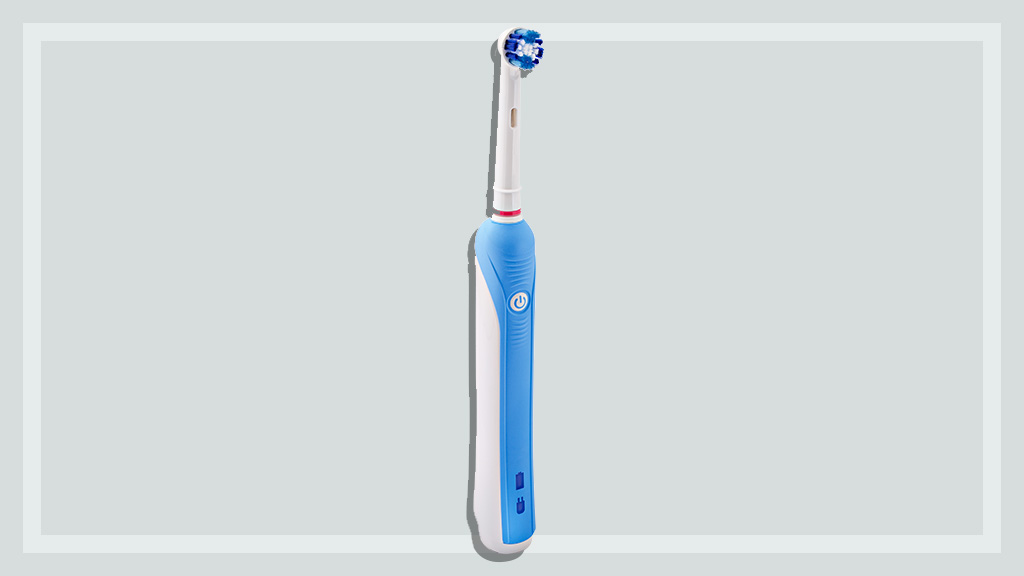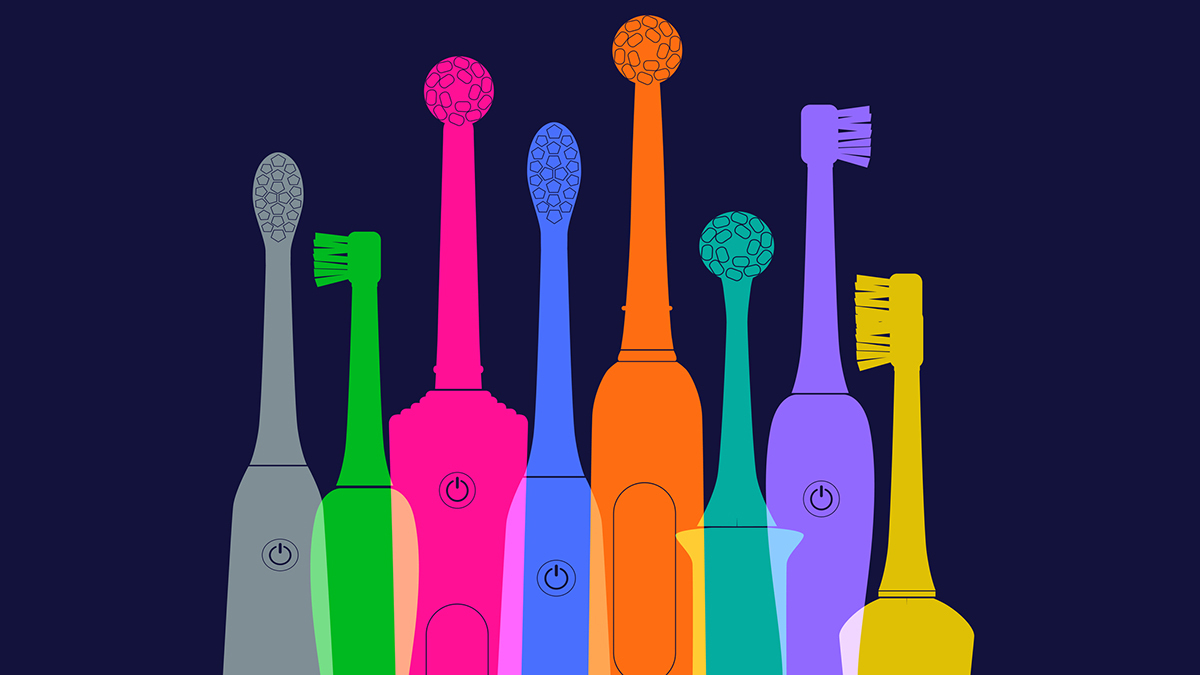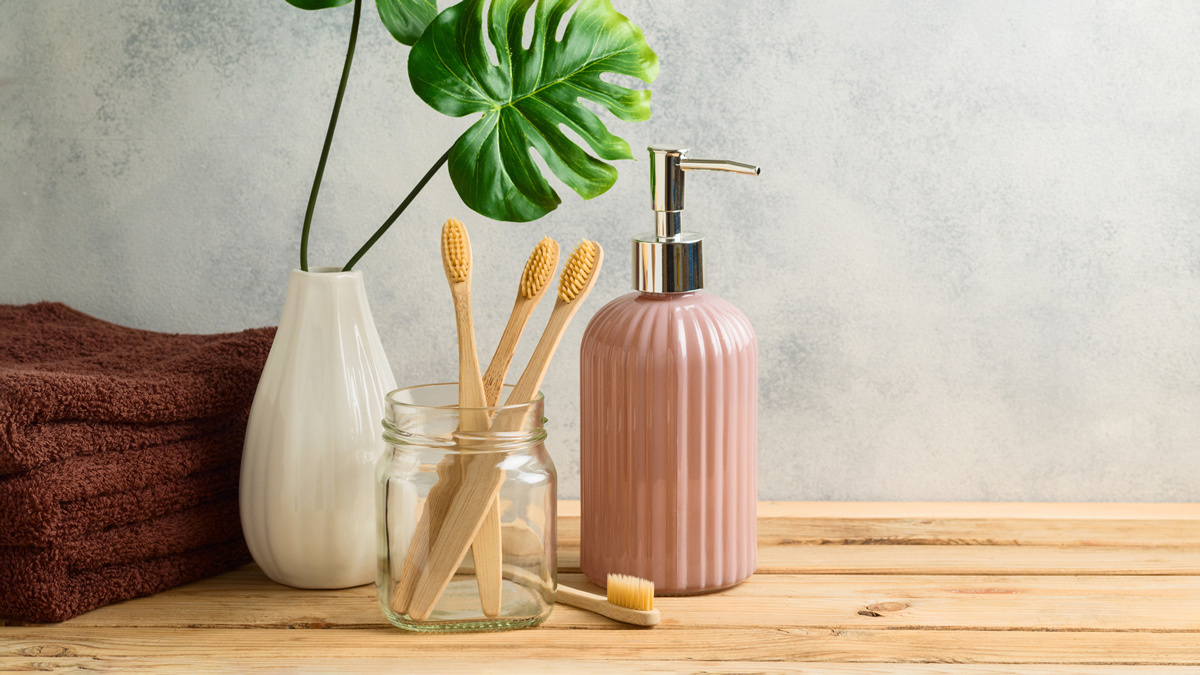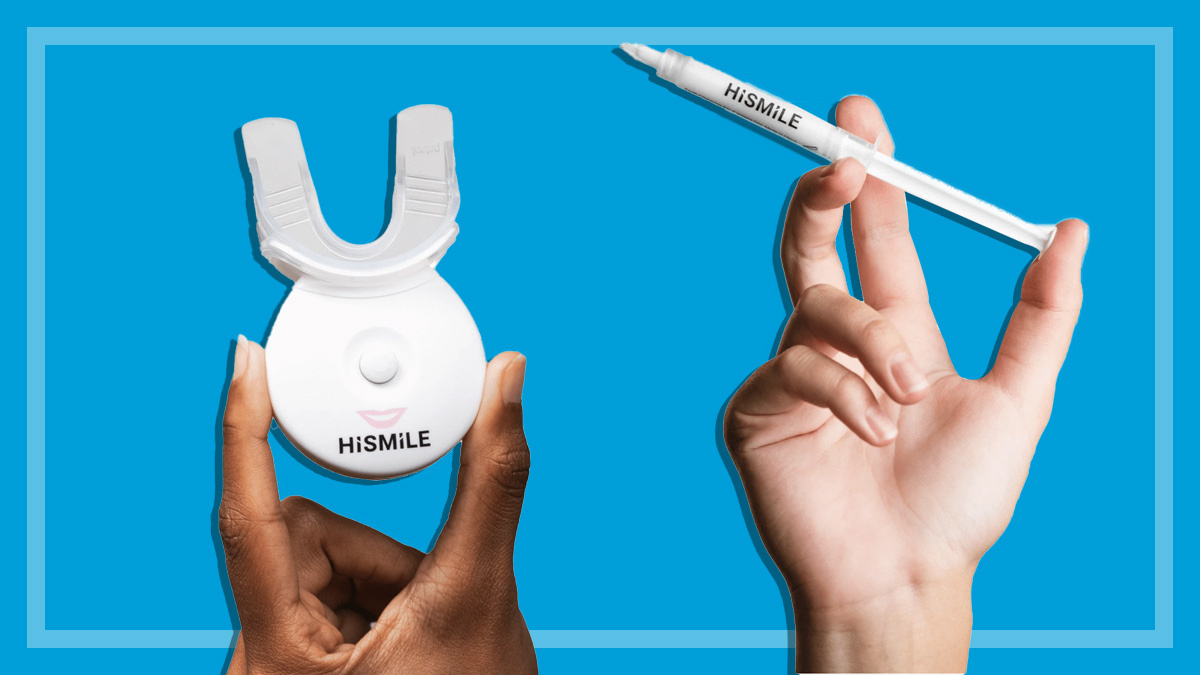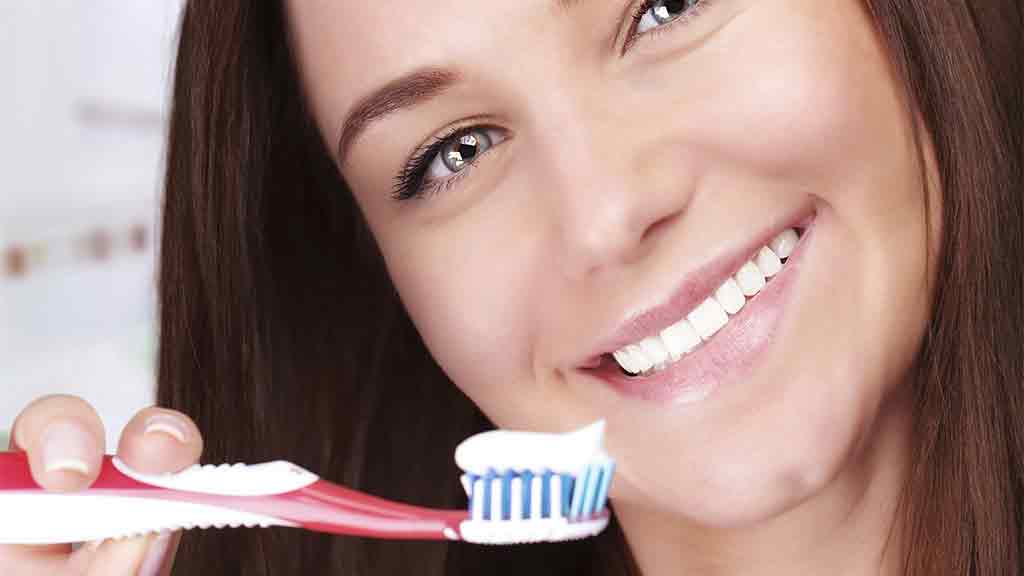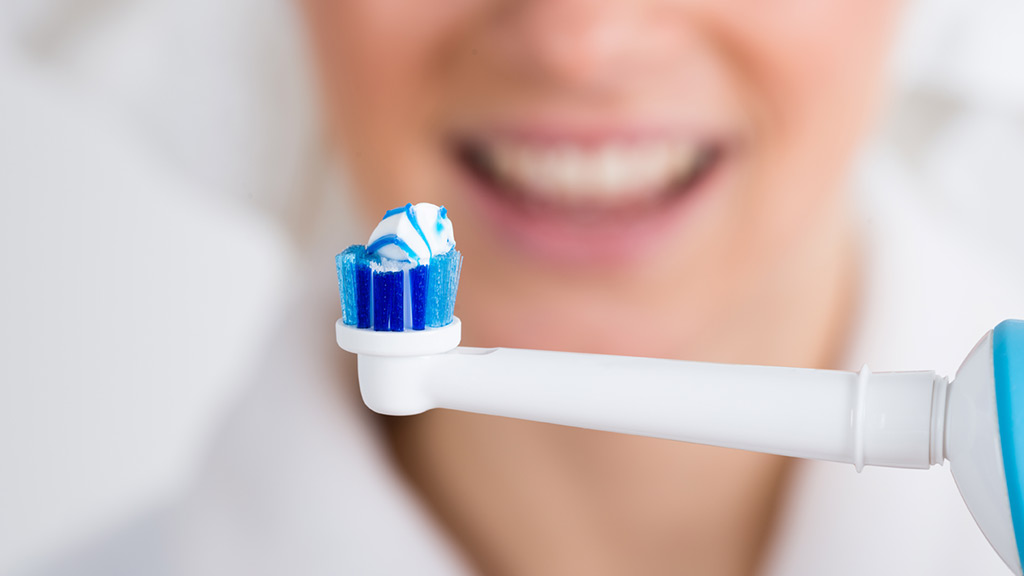Get our independent lab tests, expert reviews and honest advice.
Teeth whitening treatments

Whether it be at home, the dentist or in a salon, the desire for a bright, white smile is all the rage.
On this page:
- Salon and kiosk whitening
- Dentist whitening
- DIY teeth-whitening kits
- Teeth-whitening toothpaste
- Causes of stained teeth
Teeth-whitening products are everywhere, from whitening toothpastes, bleaching kits and adhesive strips to salons and kiosks in shopping centres – all promising lighter, brighter teeth at a fraction of the cost you’d expect to pay for a full dental-clinic treatment.
But how safe and effective are they? And what do you need to know before you jump into any of these teeth-whitening treatments?
Salon and kiosk whitening
Teeth-whitening salons offer in-chair treatments that claim to brighten smiles up to nine shades.
With little or no training and an outlay of a few thousand dollars for an activating light and bleaching equipment, pretty much anyone who has the money can establish a lucrative little earner in hair and beauty salons, shopping-centre kiosks, and even mobile home-based teeth-whitening parties.
Typically costing less than $200, it’s much cheaper than the similar teeth-whitening services that dentists offer.
The teeth-whitening industry is largely unregulated and practitioners in salons don’t necessarily have any dental training
To whiten teeth, salons typically use a bleaching gel and then expose your teeth to an activating light. But after an increase in injuries associated with teeth-whitening products, teeth-whitening preparations containing more than six percent hydrogen peroxide (18% carbamide peroxide) are now prohibited from sale, supply or use, except by registered dentists in a clinical setting.
To get around this restriction, some salons simply do more applications of the bleaching gel in one session to achieve a whiter shade, instead of using a strong ‘power-bleaching’ solution.
An unregulated industry
The teeth-whitening industry is largely unregulated and the practitioners in salons don’t necessarily have any dental training.
Practitioners can’t advise on whether the process is appropriate for you (some kinds of discolouration don’t respond to certain treatments), nor are they qualified to check for problems such as cracked enamel, cavities, restorations and exposed root surfaces that need special care.
Potential problems include lack of proper infection control, careless application and ill-fitting bleaching trays, causing irritation to gums and lips. But in most cases, the worst outcome will be temporarily sore gums and sensitive teeth.
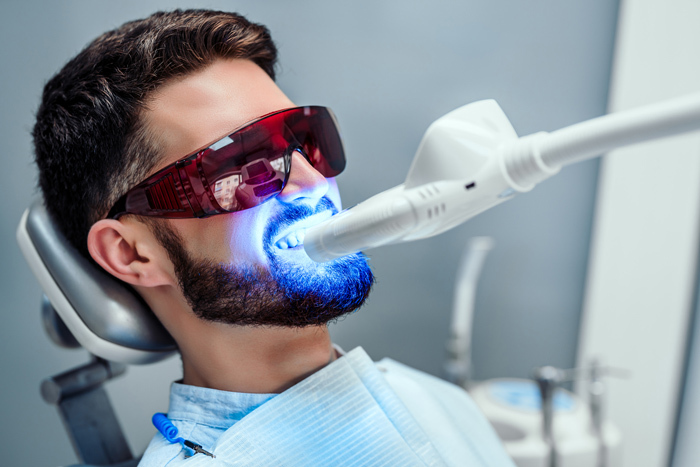
Dentist whitening
The main advantage of dentists over cosmeticians is that they’re qualified to assess the overall state of your teeth, including taking a dental history, which may have a bearing on the treatment they’re prepared to give you. They can also assess and redress any underlying problems that could be causing discolouration.
But they’re also likely to be a lot more expensive – anything from about $300 to more than $1000, depending on the complexity and sophistication of the technology they’ll need to use, and the chairside time required.
Unlike in a salon, dentists are also allowed to do what’s called ‘power bleaching’ with strong hydrogen peroxide bleach (up to 38% hydrogen peroxide). After placing a special protective material on your gums, the dentist puts the gel on your teeth, and may enhance the bleaching effect by using a light or heat source, such as a laser, LED or halogen lamps.
Whiter but more sensitive teeth
In general, the stronger the product and the longer the contact, the whiter the teeth will be. But the teeth are also likely to be more sensitive afterwards. The use of light or heat to enhance the effect of the bleach appears to have a greater whitening effect than bleach alone. But some of this extra effect appears to result from dehydration of the tooth, and the colour will darken slightly as the tooth rehydrates.
You may need more than one treatment
The effects of power bleaching are immediate, but you may need more than one treatment to get the result you want. It’s not uncommon for an initial treatment at the dental surgery to be followed up with further treatment or maintenance at home.
Dentist-supplied home bleaching kits
Your dentist can also give you an at-home bleaching kit, either as a standalone treatment or to supplement in-clinic power bleaching. These kits are likely to be more expensive because the dentist will have to make custom-fitted trays. Customised trays mean that less gel is needed and gum sensitivity is reduced. But the dentist will still make sure the strength of the bleach is right for you.
DIY teeth-whitening kits
Most whitening products (except toothpastes) contain peroxides, such as urea peroxide or carbamide peroxide. This breaks down to hydrogen peroxide (10% carbamide peroxide releases 3.5% hydrogen peroxide in the presence of water), which chemically bleaches both surface stains and the tooth itself. At a high enough concentration, peroxides can whiten teeth so that they’re lighter than your natural colour.
DIY home tooth-bleaching kits can be easily bought on the internet. The kits generally contain:
- bleach trays, which may be mouldable (you dip them in boiling water and fit them to your teeth – so-called ‘boil and bite’)
- the bleaching chemical
- a light to accelerate the process (some kits)
- remineralising gel or paste to reduce sensitivity (some kits).

They may also come as a tooth-whitening pen or adhesive strips. Although whitening pens may seem low-mess and convenient, using them without trays may not be very effective.
“Brush-on gels are the least controlled and are typically poorly performing because of concerns around irritation of gum (gingival) tissues,” says Professor Laurie Walsh from the Australian Dental Association (ADA).
“They are more likely to be inactivated by normal saliva, which has enzyme systems that break down peroxides to harmless water and oxygen.”
Brush-on gels are the least controlled and are typically poor performing
Professor Laurie Walsh, Australian Dental Association
Peroxide levels
When DIY teeth-whitening kits first hit the market, CHOICE found products with hydrogen peroxide levels as high as 16% (carbamide peroxide 44%). This finding came in spite of recommendations from the ADA that home teeth-whitening products not exceed six percent hydrogen peroxide.
Regulations now limit the strength of DIY kits to six percent hydrogen (18% carbamide peroxide). Nevertheless, one of the kits recommended by several Australian magazines contains 35% carbamide peroxide and can be readily ordered online from the US.
Peroxide safety
Try to avoid bleach contact with gums as much as possible, and avoid swallowing the bleach. There is some concern, though no conclusive evidence, that peroxides may cause oral cancer, although it’s more likely in people already at risk – smokers and those who abuse alcohol.
Excessive bleaching attempts can damage enamel, as can poorly formulated or over-acidic products. You may end up with more porous enamel, a bluish tinge and/or brittle teeth.
Some people can also experience temporary tooth or gum sensitivity when using home bleaching products.
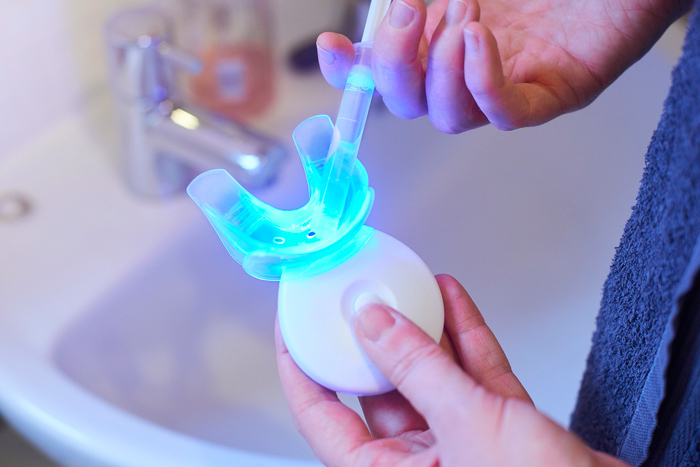
A better fitting tray
The fit of the bleaching trays is an important aspect of this sort of teeth whitening. If you’re leaving them on for a long time (30 minutes or so), they need to be comfortable, and not cause gagging or excessive salivation.
The closer they fit, the less bleaching product you need to use. Excessive bleach can ooze out, and while not toxic in small amounts, it can taste unpleasant and may damage soft tissues.
Custom-made trays
Rather than giving you a boil-and-bite tray, some DIY kits get you to make impressions of your teeth, and send them back to the distributor. The distributor then makes and posts out a set of custom-fitted trays for you – much like those a dentist would make. They’re a little more expensive, but you can use them for many years.
Pre-filled trays
These promise the convenience of not having to muck around with tubes of bleaching gel and so on. But because they’re one-size-fits-most, there needs to be a lot of gel in them to make sure all teeth have contact with the active ingredient. This means that excess gel oozes out and irritates the gums.
Do desensitisers help?
Some home whitening gels include ingredients that can help prevent sensitivity, including potassium nitrate, arginine compounds and calcium phosphate compounds. These are also found in toothpaste for sensitive teeth.
How effective they are very much depends on how it’s applied.
No desensitising product can totally prevent the reaction of the dental pulp of teeth to a bleaching treatment
Professor Laurie Walsh, Australian Dental Association
“Including it in the gel only makes sense for products with low levels of peroxide that are worn overnight in trays, because there is enough contact time,” says Professor Walsh.
“Putting a desensitiser into a product applied for only 20 to 30 minutes or so will not give much effect, as the exposure time is far too short. Often people undergoing bleaching find that using a separate desensitising product is easier and more effective.”
But Professor Walsh also warns: “No desensitising product can totally prevent the reaction of the dental pulp of teeth to a bleaching treatment, so people should not expect that. Also, the reaction of teeth to bleaching is not reduced or alleviated by taking painkillers, such as paracetamol.”
Do the blue LED lights in over-the-counter teeth whitening kits really work?
These items of techno whizz-bangery may look the business, but how helpful are they? Some studies find they increase the whitening effect of the gels, while other studies find they don’t.
Professor Walsh says, “Generally these small blue LED lights do not provide much benefit because the gels lack the absorbers (chromophores) for photothermal actions, or the photosensitizers for photochemical or photodynamic activation from visible blue light.
“In other words, you need the right chemical ingredients to get a benefit from using light. This is why some studies find benefits but others don’t. It’s all about having the correct light absorbing compounds present in the gel.
“Teeth may look whiter initially, but this is often due to a dehydrating effect. As water is taken back up by the teeth, relapse occurs. Clinical studies have shown this relapse occurs with various systems, including those using blue light.”
DIY bleaching tips
If you’re going to go down the DIY home bleaching path:
Talk to your dentist first
Before you buy any whitening product, we’d recommend talking to your dentist about the particular type of stain that affects your teeth. Doing so will help you avoid wasting money – and effort – on a product that may not work for you.
Be prepared for increased sensitivity
Greater sensitivity is highly likely, but using the product less often will help, although the whole process will take longer. Ask your dentist about toothpaste or other products that may help reduce sensitivity.
Don’t over-bleach
Don’t use more product (it won’t help), leave it on too long or do it too often. And you only really need to bleach the front surface of your teeth.
Choose products only from reputable Australian suppliers
Don’t be tempted to save a few dollars buying unreliable products subject to poor hygiene and quality control. And be aware that products from overseas may exceed the permitted levels of peroxides.
ADA raises concerns with the ACCC
When we asked the ADA for comment on teeth-whitening products, it told us it had raised a number of concerns in a submission to the Australian Competition and Consumer Commission (ACCC) – in particular with regard to DIY home kits, which the ADA found to be the most popular non-dentist route to whiter teeth.
Issues included:
- the availability of products that exceed the allowable limits of hydrogen peroxide – mainly from overseas but readily available online
- false and misleading statements about the degree of whitening people could expect
- certain sales and marketing strategies that encourage excessive and potentially hazardous use of whitening products.
Exaggerated whitening effects (“up to 12 shades”) are not only misleading, but they could also lead somebody who is disappointed by the initial result to overuse the products unsafely. For example, they might overfill the trays with gel, and/or apply whitening agents more frequently and for longer than is recommended.
The ADA is also concerned that some kit suppliers encourage excessive use of the products, such as recommending daily use until you’re happy with the results, and then fortnightly or weekly for ‘maintenance’. Many also sell whitening pens for daily use, marketed as “perfect for touch-ups and on the go teeth whitening”.
Potential dangers of over-using whitening products
Overusing teeth-whitening products can weaken tooth enamel, leading to a higher risk of cavities. It can also cause other oral and general-health issues.
There have also been no long-term studies of the effects of DIY teeth whitening. Studies that have attempted to simulate the long-term effects of bleaching use dentist formulas and exclude people with certain dental issues for whom whitening may not be safe. Although (legal) DIY kits are not as strong as the products dentists use, they’re often more acidic, which can increase the damage. They’re also used by people with dental issues that dentists wouldn’t do teeth whitening on.
The ADA sent the submission in May 2019 and have not yet received a response.
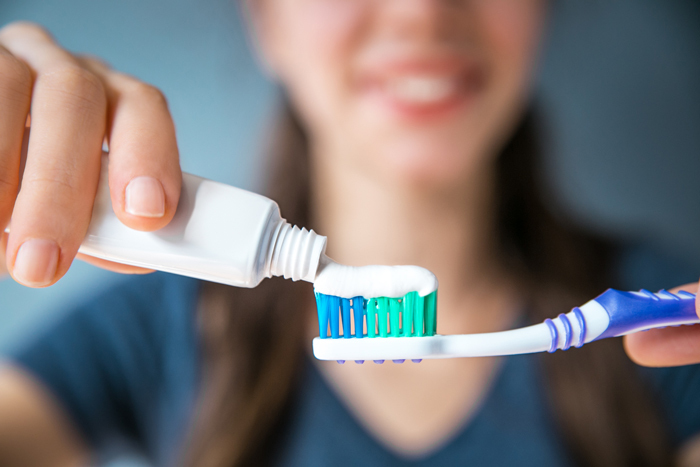
Teeth-whitening toothpaste
Most tooth-whitening products will use some sort of abrasive to remove stains, but some also use other ingredients.
Abrasive agents
Abrasives (such as alumina, silica/hydrated silica and dicalcium phosphate) remove surface stains by physically rubbing them off the surface of the teeth. Charcoal has become a popular ingredient in whitening toothpastes, but there’s no evidence that it’s effective and it’s been linked with greater enamel wear and cavities.
Bleaching agents
Hydrogen peroxide is found in some toothpastes but is unlikely to have much effect when in contact with teeth for a short time. As Professor Walsh explains, “stimulation of saliva by brushing will hasten the breakdown of peroxides. This is why such products have limited effects, mostly on dietary stains, but do not change the internal colours of tooth structure”.
Detergents (such as sodium lauryl sulphate)
These act as foaming agents and help to clean the tooth surface.
Enzymes (such as papain, derived from papaya)
These slow down the build-up of ‘pellicle’ — the protein-containing layer of saliva that forms on your teeth within a minute of brushing. Surface stains stick to the pellicle layer.
Polyvinylpyrrolidone (PVP)
This stops stains accumulating on the tooth surface. Interestingly, it was also the main ingredient in the first really successful hairsprays in the 1950s!
Sodium hexametaphosphate
This acts as a repellent for stains and also displaces them from the surface of teeth.
Other ingredients
Ingredients such as tetrasodium pyrophosphate, pentasodium triphosphate, citric acid, sodium tripolyphosphate (Triclene) chemically alter the electrical charge on the stains so that they’re less able to stick to your teeth.
Causes of stained teeth
The natural colour of people’s teeth varies from white to yellow, with every shade in between. All teeth contain red and grey colours, and the grey colours increase with age.
Teeth are made up of three layers: tough outer enamel, softer dentine, and the inner pulp. As you get older, the enamel thins through wear and tear, and the darker dentine layer can begin to show through. The dentine structure also changes as it takes up more minerals from the pulp. These two processes can make older teeth look yellow.
As well as genes and aging, tooth colour depends on many other factors, of which general health (when your teeth are forming) and diet and lifestyle (once your teeth have fully formed) are key.
Health
Your health – particularly during your early years when your teeth are still developing – can be the cause of intrinsic stains, which affect the colour of the tooth itself. For instance, certain antibiotic drugs, such as some forms of tetracycline, can affect tooth colour during development, as can severe fevers.
Damage to the forming tooth can also cause internal discolouration, as can damage to the pulp of a permanent tooth (as a result of receiving a blow during contact sport, for example).
Diet and lifestyle
Lifestyle and diet can cause surface stains. Tea, coffee and smoking are three of the biggest culprits, followed by red wine, coloured berries and soy sauce, and coloured drinks such as colas.
All teeth contain red and grey colours, and the grey colours increase with age
Stain removal
Surface stains
Many whitening products specifically refer to surface-stain removal as one of their methods of whitening. A professional clean at the dentist can also remove surface stains (including those between the teeth), often producing a fresher, whiter appearance.
Deeper stains
Although removing surface stains can restore teeth to their natural colour, this doesn’t necessarily mean your teeth will be whiter. Deeper stains are more difficult to remove and may not respond well to home-bleaching treatments, or even to the special bleaches and whitening treatments that dentists use. If the tooth is very badly stained, some type of veneer might be needed to disguise the area.
So before you spend money on DIY whitening, speak to your dentist about treatment options for the particular type of stain affecting your teeth.
Five tips for teeth-whitening services
- Avoid staining your teeth with tea, coffee, red wine, cola and smoking for a couple of days after whitening (which may mean giving them up for a few weeks for longer-term treatments).
- If you don’t want to give up certain drinks, you could try drinking them through a straw to reduce staining.
- Bleach won’t whiten caps, crowns or fillings, so these may need to be replaced if they no longer match the rest of your teeth.
- Your teeth may need re-whitening after a couple of years or so.
- Have realistic expectations – keep in mind that many photos of models and celebrities have been digitally manipulated to make their teeth look whiter, or they may have had veneers fitted in real life. Your teeth shouldn’t be whiter than the whites of your eyes – if they are, they can look unnatural.

